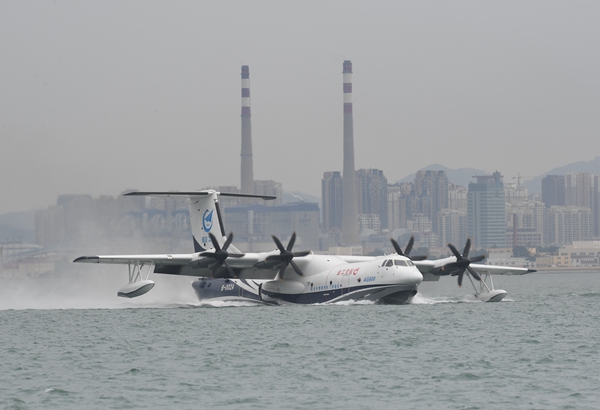Inside AG600's historic maiden sea-based test flight

An AG600 "Kunlong" amphibious aircraft slides on the sea off Qingdao, east China's Shandong province, July 26, 2020. [Photo/Xinhua]
On July 26, China's domestically developed amphibious aircraft, the AG600 Kunlong, took off from Rizhao Shanzihe Airport on a clear day. It successfully completed its first sea-based test flight off the coast of Qingdao in Shandong province, flying for a total of 1 hour and 21 minutes.
The event marked the AG600's third successful maiden flight, following one over land in 2017, and a first flight over water in 2018 when it took off and landed on a reservoir in southern China.
The flight has been another milestone achievement by the Aviation Industry Corporation of China (AVIC) since it implemented its innovation-driven strategy, and accelerated the development of its manufacturing and science and technology capabilities.
Overcoming difficulties in flying over water
Liu Ying, deputy chief designer of the AG600, told Science and Technology Daily that it is relatively safe for an aircraft to take off and land on a hard runway where the landing gear acts as a buffer. However, takeoffs from water or the sea consist of two steps: landing on the water's surface and accelerating to become airborne.
Taking off and landing on the sea are especially dangerous because of challenging sea conditions, with waves shaking and bouncing the aircraft. In the worst-case scenario, the aircraft itself can be overturned.
The first three flight tests of the AG600 were designed to ascertain whether the different functions of the aircraft would perform as intended. The first flight over land was conducted to verify the basic flight performance of the aircraft. Its first over water was designed to test the ability to respond to sudden emergency situations. Finally, the plane's first flight over the sea was carried out to test the aircraft's performance in long-range maritime rescue, as well as sea wave resistance, and corrosion prevention.
Tackling unique challenges
There are three main differences when aircraft take off from freshwater compared with the sea.
First, seawater has much higher salt levels than freshwater. High salinity places greater demands on aircraft in terms of corrosion prevention.
Second, seawater's higher density means that its reactive force is higher. This difference in density can make the pilot feel as if freshwater — such as in lakes and reservoirs — is relatively "harder."
Third, the sea environment is more complex than that of lakes and reservoirs. Relatively calm bodies of water without much disturbance allow aircraft to take off and land in accordance with the wind direction and waves. However, there are more problems on the sea. These include differing types of waves with varying height and energy, as well as ocean currents and changing winds.
"The two maiden flights over water and the sea have different visual experiences and control requirements for pilots. The surface of the sea is more open, so it's not as easy for pilots to choose a reference point when landing as they do on lakes and reservoirs," explained Liu Ying.
During the test flight, it was necessary to fully consider the wind direction, wind speed, ocean currents and surges, as well as the combined effects of a high-temperature, high-humidity, and high-salt environment. Taking off and landing on the sea places higher requirements on the aircraft's stability, handling, and anti-corrosion. In addition, providing support for sea-based test flights is also more complicated.
Corrosion and wave resistance tests
When taking off and landing on rough seas, water splashing onto the aircraft is potentially a serious problem, which may cause distortion or even damage to structural components such as flaps and propellers.
The aim of the AG600's maiden flight over sea was to test the aircraft's splash characteristics, wave resistance, acceleration abilities and handling on the sea's surface; to examine how the AG600 systems work in a marine environment; and to collect additional flight data, which can then be used in subsequent work on the aircraft, Liu said.
At the same time, regarding the corrosion caused by the high salinity and high humidity of the sea, the anti-corrosion abilities of the aircraft will also be evaluated. These tests will allow the aircraft to perform such tasks as maritime cargo transportation and water-based emergency rescues in the future.
In Liu's opinion, whether it is the first flight over sea, water or land, it is important to verify the different flight functions and characteristics, and ensure the performance and safety of the aircraft for future flights.
As part of China's large family of domestically produced airplanes, the AG600 is China's first independently developed large-scale specialized civilian aircraft. It is also an important aviation tool which is urgently needed in the construction of China's nationwide emergency rescue system.
Editor: John Li